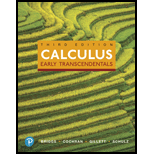
Asymmetric integrands Evaluate the following
77.
Want to see the full answer?
Check out a sample textbook solution
Chapter 8 Solutions
Calculus: Early Transcendentals (3rd Edition)
Additional Math Textbook Solutions
Introductory Statistics
Intro Stats, Books a la Carte Edition (5th Edition)
University Calculus: Early Transcendentals (4th Edition)
Elementary Statistics (13th Edition)
Calculus for Business, Economics, Life Sciences, and Social Sciences (14th Edition)
Thinking Mathematically (6th Edition)
- The graph of f(x) is given in the figure below. draw tangent lines to the graph at x=-3,x=-2,x=1,and x=4. estimate f'(-3),f'(-2),f'(1),and f'(4). Round your answers to one decimal place.arrow_forwardConsider the functions f(x)=4x-1 and g(x)=sq root of -x+7. Determine 1. f o g(x) 2. Give the domain of f o g(x) 3. g o f (x) 4. Give the domain of g o f(x)arrow_forward12. lim h→0 √5x+5h -√5x h where x>0 is constaarrow_forward
- Example 1 Solve the following differential equations: dy dx ex = 3x²-6x+5 dy dx = 4, y(0) = 3 x dy dx 33 = 5x3 +4 Prof. Robdera 5 -10:54 1x ㅁ +arrow_forward21. First-Order Constant-Coefficient Equations. a. Substituting y = ert, find the auxiliary equation for the first-order linear equation ay+by = 0, where a and b are constants with a 0. b. Use the result of part (a) to find the general solution.arrow_forwardLet f be a function whose graph consists of 5 line segments and a semicircle as shown in the figure below. Let g(x) = √ƒƒ(t) dt . 0 3 2 -2 2 4 5 6 7 8 9 10 11 12 13 14 15 1. g(0) = 2. g(2) = 3. g(4) = 4. g(6) = 5. g'(3) = 6. g'(13)=arrow_forward
- Algebra & Trigonometry with Analytic GeometryAlgebraISBN:9781133382119Author:SwokowskiPublisher:Cengage
